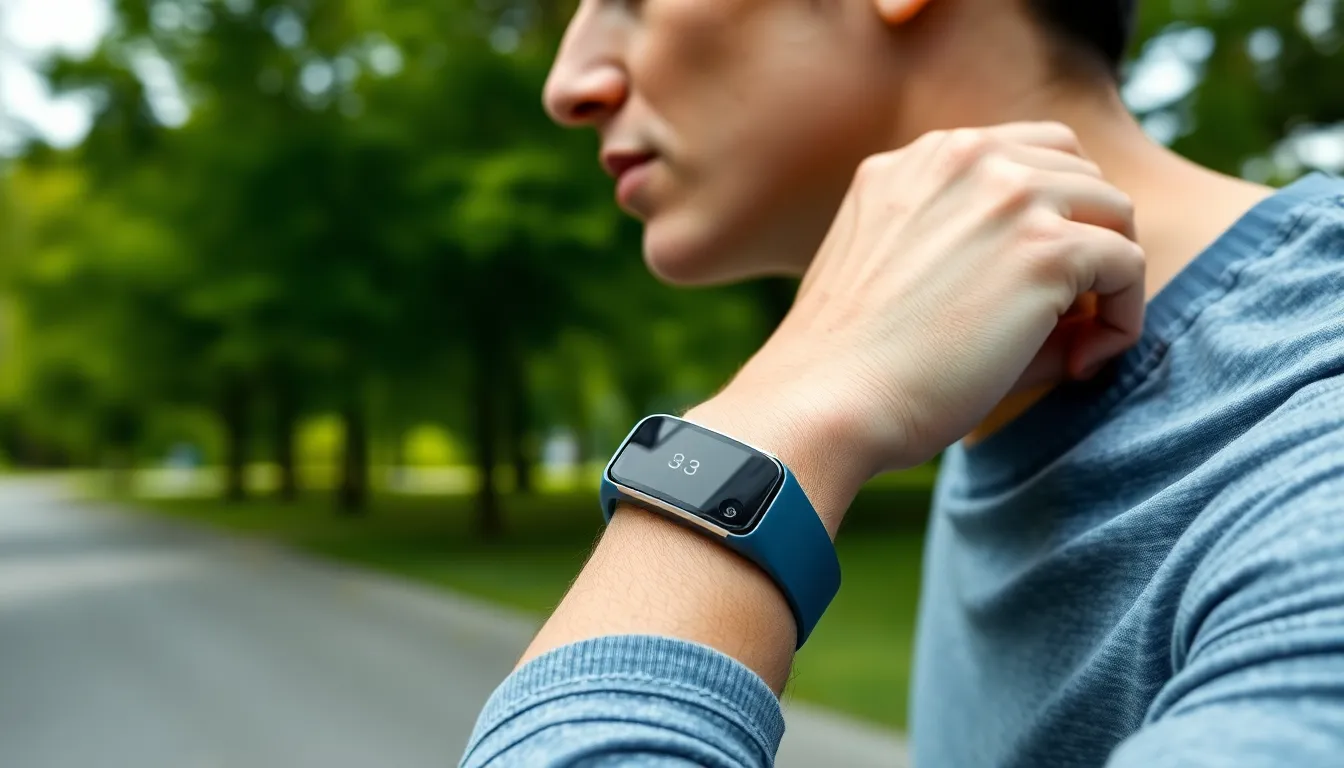In a world where gadgets are practically an extension of our bodies, wearable technology has taken center stage. From smartwatches that track your every heartbeat to fitness bands that promise to turn you into a gym god, these devices are more than just fancy accessories. They’re the tiny, tech-savvy friends that nudge you to get off the couch and maybe even do a few squats—no judgment here.
Table of Contents
ToggleOverview of Wearable Technology
Wearable technology includes devices that users can wear on their bodies for various functions. Smartwatches, fitness trackers, and smart glasses represent popular categories within this technology. Each device integrates seamlessly with smartphones, enabling notifications and health tracking in real-time.
Fitness trackers monitor physical activity, heart rate, and sleep patterns, providing users valuable insights into their health. Many users appreciate these features for motivating them to maintain or increase physical activity levels. Smartwatches, on the other hand, function as mini-computers on the wrist, allowing users to answer calls, reply to messages, and control music playback.
Health monitoring is a significant feature of wearable devices, with some models offering advanced metrics such as blood oxygen levels and ECG readings. Meditation and mindfulness apps also work alongside these devices to enhance users’ overall well-being.
Smart glasses present a unique opportunity for augmented reality experiences, enhancing how users interact with their environments. These devices support various applications, from navigation assistance to real-time information displays, making technology more accessible.
Wearable technology has matured significantly, with advancements in battery life and functionality. Consumers now prioritize compatibility with mobile operating systems and ease of use. The ongoing development of this technology continues to transform how individuals approach fitness and daily activities. Wearable devices are not just tools; they are now essential companions in promoting a healthier lifestyle.
Types of Wearable Technology

Wearable technology encompasses a diverse range of devices that enhance daily living and promote well-being. Key categories include fitness trackers, smartwatches, and health monitors.
Fitness Trackers
Fitness trackers focus on activity monitoring and health data analysis. These devices can count steps, track distance, and calculate calories burned. Heart rate monitoring features offer insights into physical exertion levels. Many users appreciate the sleep tracking capabilities, which provide valuable information on sleep patterns. Popular brands include Fitbit and Garmin, which deliver reliable data to help individuals set and achieve fitness goals.
Smartwatches
Smartwatches offer a combination of functionality and style. They provide notifications for calls, messages, and social media alerts directly on the wrist. Users can access apps for music, workouts, and weather updates, making them versatile companions. Health monitoring features include heart rate tracking and ECG readings, enhancing their value beyond basic timekeeping. Brands like Apple and Samsung lead the market with user-friendly interfaces and extensive app ecosystems.
Health Monitors
Health monitors serve a critical role by tracking various health metrics. These devices can measure blood sugar levels, monitor blood pressure, and assess oxygen saturation. Real-time insights assist users in managing chronic conditions effectively. Integrating with smartphones, health monitors allow seamless data analysis and sharing with healthcare professionals. Devices from brands like Oura and Withings provide comprehensive health tracking, promoting proactive healthcare management.
Key Features to Consider
When selecting wearable technology, understanding key features enhances the decision-making process. Two crucial aspects stand out: battery life and compatibility.
Battery Life
Battery life influences the usability of wearable devices. Users prefer devices that can last at least a full day without needing a recharge. Most smartwatches and fitness trackers provide battery endurance ranging from 24 hours to several days, depending on usage. High-performance devices often include power-saving modes, allowing for extended functionality during critical times. Look for models that indicate battery life based on specific usage patterns, such as tracking workouts or receiving notifications. Users frequently favor brands that offer fast charging capabilities, ensuring quicker access to functionality when it matters most.
Compatibility
Compatibility ensures seamless integration with smartphones and other devices. Many wearable products today operate best with specific operating systems; for example, Apple Watch typically works only with iOS devices. Some brands, like Fitbit and Garmin, support both Android and iOS, providing greater flexibility. Users value cross-platform compatibility as it allows them to access data on various devices. Checking the app ecosystem is important since it determines available features and overall user experience. Ensuring that the chosen device connects effortlessly with apps facilitates better health tracking and communication features, enhancing the overall experience.
Popular Brands and Models
Wearable technology features several well-known brands and models, each offering unique capabilities and benefits.
Apple
Apple excels in the smartwatch market with the Apple Watch series. Known for its sleek design and user-friendly interface, it integrates seamlessly with iOS devices. Health tracking features include heart rate monitoring and ECG capabilities, along with fitness metrics. Users appreciate the extensive app ecosystem, which supports everything from workout apps to mindfulness programs. The Apple Watch also offers features like cellular connectivity, enabling users to stay connected without needing their phone nearby.
Fitbit
Fitbit dominates the fitness tracker segment, appealing to health-conscious individuals. Its devices, such as the Fitbit Charge and Versa series, emphasize activity tracking, sleep monitoring, and heart rate analysis. Users benefit from personalized insights that motivate them to reach their fitness goals. Additionally, Fitbit’s easy-to-use app provides a comprehensive view of health data, including insights into nutrition and hydration. The sleek design of Fitbit wearables makes them comfortable for all-day use, ensuring that users can track their activities consistently.
Garmin
Garmin stands out as a leader in multisport tracking with its range of devices like the Forerunner and Fenix series. These models cater to athletes in various sports, offering advanced metrics like VO2 max and recovery time. Built for durability, Garmin wearables often exhibit long battery life, accommodating extended outdoor activities. Furthermore, the devices include navigation features, ensuring participants can explore new trails confidently. Users also appreciate Garmin’s compatibility with different sports apps, which enhance their training experience.
User Experiences and Feedback
User experiences with wearable technology vary widely, showcasing both advantages and disadvantages. Many users enjoy the convenience and functionality these devices offer in everyday life.
Pros and Cons
Benefits of wearable technology include enhanced health tracking capabilities and ease of access to notifications. Users appreciate real-time data, which can motivate them to reach fitness goals. Advanced health metrics help individuals manage conditions like diabetes and hypertension effectively. Notably, longer battery life in newer models increases usability. However, some users experience frustration with limited compatibility across devices and platforms. High prices also deter potential buyers from investing in the latest models. Overall, the balance between functionality and cost remains a critical consideration for consumers.
Common Issues
Common issues arise from device connectivity and software compatibility challenges. Users frequently report syncing problems between their smartwatches and smartphones, hindering data access. Battery depletion often occurs faster than expected, with many devices only lasting a day before requiring a charge. Additionally, inconsistent performance of health tracking features sometimes leads to mistrust in the data provided. Users also encounter difficulties with software updates, slowing down device functionality. Despite these challenges, user feedback continues to drive improvements in product design and performance.
Wearable technology is reshaping how individuals engage with their health and daily routines. These devices not only enhance fitness tracking but also foster a greater awareness of personal well-being. As advancements continue to emerge in design and functionality users can expect even more innovative features that cater to their needs.
The growing ecosystem of wearable devices offers something for everyone from fitness enthusiasts to those managing chronic conditions. With brands constantly refining their offerings the future of wearable technology looks promising. As users embrace these tools they’ll likely find new ways to stay motivated and connected in their everyday lives.





